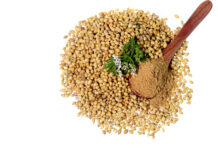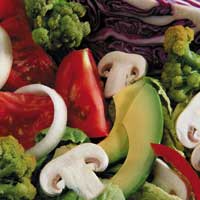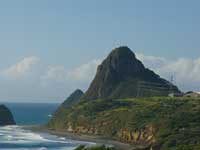
The trace mineral selenium is an immune-booster and antioxidant, killing cancerous and pre-cancerous cells, and preventing damaged DNA from reproducing.
The trace mineral selenium, found in rocks and soil, is now widely believed to be one of the most important trace minerals needed in the human diet, although only in small quantities.
Â
Immune-booster and antioxidant
Perhaps the most important function of selenium is as an immune-booster and antioxidant. It activates an enzyme in the body known as glutathione peroxidase, which enters cell proteins and halts oxidative stress caused by free radicals. This kills cancerous and pre-cancerous cells, and damaged DNA is prevented from reproducing.
Research indicates that selenium may help prevent cancer, especially lung, prostate and colon cancers. In 1996, an edition of the Journal of the American Medical Association featured a 10-year placebo study by Dr. Larry Clark at the University of Arizona. Those who took a 200-microgram (mcg) daily selenium supplement experienced a 45 per cent drop in cases of lung cancer, a 58 per cent lower incidence of colon cancer and a 63 per cent drop for prostate cancer.
{quotes}For cancer patients on chemotherapy, selenium has been found to enhance its effectiveness while reducing its toxic effects{/quotes}
Many studies suggest that selenium supplementation may also help shrink cancer tumours. In the University of Arizona study referred to earlier, overall cancer mortality dropped by 50 per cent. It is significant that for all test subjects the selenium blood plasma level never dropped below the Food and Drug Administration’s threshold that marks a ‘deficiency’ condition.
For cancer patients on chemotherapy, selenium has been found to enhance its effectiveness while reducing its toxic effects.In this respect, it is different to other antioxidants, which can interfere with the action of chemotherapy agents.
Selenium has also been found to be good for the liver, thyroid, heart, eyes, and people with AIDS. Research in the UK has shown that fertile men have more selenium in their sperm than infertile men. It is also a useful aid in the detoxification of heavy metals, combining easily with cadmium and mercury and enabling them to be removed from the body.
Recommended intake
Australia’s Recommended Daily Amount (RDA) for selenium currently stands at 85 mcg for men and 70 for women. It is important, however, to recognise that an RDA represents an estimate of the daily amount necessary for a healthy person to avoid developing what is termed a ‘frank’ deficiency. This will obviously be lower than what is needed to reach optimum health and significantly reduce the risk of disease.
Australia’s daily maximum intake of a selenium supplement is 150 mcg, with no distinction between organic and inorganic. It has been argued that people eating high-fat diets, those who are ill, and those with malabsorption issues may benefit from taking a higher amount. In addition to food sources, American supplement companies suggest a daily dose of up to 200 mcg daily, and selenium works most effectively in conjunction with vitamins C and E, and the nutrient beta-carotene.
{quotes}Research in the UK has shown that fertile men have more selenium in their sperm than infertile men {/quotes}
Selenium supplements come in two forms. The organic variety, ‘yeast selenium’, is most frequently found in nature and is more bio-available. Containing the two amino acids selenomethionine and selenocysteine, it is the type recommended by many naturopaths. A second option is to take the inorganic mineral forms of selenium (sodium selenite or sodium selenate), both of which are less bio-available. If selenite is combined with vitamin C, the biological activity of the selenite is neutralised.
The US National Academy of Sciences suggests a daily upper limit of 400-450 mcg. This dosage is low enough to avoid the risk of developing selenosis, a human selenium toxicity characterised by a garlic odour on the breath, a metallic taste, nervousness and hair loss. Selenium poisoning from supplementation is rare.
Avoiding a deficiency
In addition to the harmful effects from too much selenium, taking too little causes other health symptoms. The Linxian district of Western China has selenium-deficient soils, and has been dubbed the ‘world capital of cancer’. Two other selenium deficiency conditions encountered there are Keshan disease (a heart muscle disorder), and Kashin-Beck disease (a kind of deforming arthritis.)
Surveys in the UK and Europe have also revealed worryingly low and falling selenium levels. This downward trend has been linked to sulphur dioxide from coal-fired power stations, and the use of sulphur fertilisers, which inhibit selenium uptake by plants. In response, Finland has legislated that selenium must be added to soils, and UK supermarket chain Waitrose has launched its own selenium-fortified bread.
Some parts of Australia have selenium-deficient soils, including Tasmania, Kangaroo Island and coastal areas of Queensland and New South Wales. The best indication of human selenium levels comes from a series of South Australian blood donor tests conducted between 1977 and 2002. While these are not necessarily typical of the general population, they do show that levels are reasonably high, although they were dropping steadily, possibly because of modern agricultural practices.
Food Sources of Selenium
| Mushroom | Â Onion |
| Egg Yolk | Â Broccoli |
| Tuna | Â Asparagus |
| Crab | Tomatoes |
| Poultry | Wheat |
| Liver | Wheat Germ |
| Kidney | Brazil Nuts |
| Garlic | Â |
Â
Â
Â
Â
Â
Â
Â
Selenium content of Australian food has not been properly researched, and investigation would be advantageous.
The amount found in vegetables and grains depends on the soil, so it varies from region to region. Although organically grown food has more selenium, the element can be lost from food through processing and cooking.
Wheat is particularly important, as it makes up about half of the average Australian’s selenium intake. Researchers at the University of Adelaide have suggested breeding a high-selenium variety. This would provide health benefits to Australians, and in all the countries that receive Australian wheat exports.
By far the best food source is the Brazil nut. Shelled nuts contain somewhere between 12 to 25 mcg each, and unshelled nuts are the best of all with around 100 mcg per nut. A further benefit in buying Brazil nuts is that you are helping to preserve the Amazon rainforest, where they originate.










































